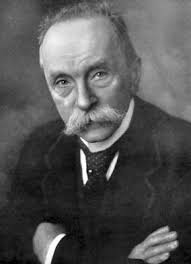History of Orthopaedics
Themistocles Glück (1853-1942): Pioneer of Total Joint Arthroplasty
 Temiloluwa Olufemi
Temiloluwa Olufemi
The art and science of medicine is dynamic, with every field evolving over the years. In Orthopaedic Surgery, total joint arthroplasty is widely considered as one of the major revolutions of the twentieth century with a proven track record of pain relief, improved functional outcome and quality of life. While Sir John Charnley is widely acclaimed as the Father of Modern Total Hip arthroplasty, Professor Themistocles Glück is credited with performing the first joint replacements in the knee, wrist, hip and shoulder.

Themistocles Glück was born on November 30th, 1853 in Iasi, Moldovia (now Romania) to German migrant parents following the death of two children. He graduated from a Prussian high school in 1873, after which he worked with his father, a reputable medical doctor and personal physician to the Romanian King Carol I. Later in the year, he began premedical terms in Leipzig and after 2 years of studying under Wilhelm His, he proceeded to Berlin for his clinical terms where his teachers included Bernhard von Langenbeck and Rudolf Virchow. An erudite scholar, he graduated in 1876 and became an Assistant Professor 7 years after his graduation - a very rare feat. His interest in tissue replacement was sparked very early and he received the Berlin University award in 1878 for his research with Virchow on nerve nutrition and regeneration.
He worked as an army surgeon during the Balkan wars in 1877 and the Serbian-Bulgarian War in 1885-1886. Gluck experimented with varying methods of adhering implants to bone in order to bridge bone and joint defects using materials such as wood, glass, aluminium and nickel-plated steel. He fixed a fractured femur with two steel plates secured with screws, and replaced a resected mandible with a steel plate fixed to bone with excellent results. He considered ivory a better material and after successful use in animal models, he implanted ivory cylinders in fractured bones with stable fixation as a precursor to the Kuntscher nails. He was the first to experiment with bone cement using different materials including copper amalgam, Plaster of Paris, and a stone putty (resin with pumice or gypsum) and predated the work of John Charnley by about 65 years. He also predated Alexis Carrel’s work on vascular repairs by performing vessel sutures and venous grafts in the 1880s.
Although life’s many twists and turns forced him to practise industrial medicine for about 6 years while he was unable to continue his university career or obtain a leading surgical position in Germany or Romania, things turned around in 1980 when Gluck was appointed Chief of the Surgical department at the new “Kaiser-und-Kaiserin-Friedrich-Krankenhaus” (Emperor and Empress Friederich Paediatric Hospital) in Berlin-Wedding, where he continued his work until the end of his career in 1924.
History was made on 20 May 1890 when he successfully performed the first total knee replacement in a 17-year-old female with damaged knees using ivory prosthesis. Three weeks later, he performed a total wrist replacement using ivory in a 19-year-old male with tuberculous arthritis and eventually developed the first ball-and-socket hip replacement. That year, he performed a total of 14 arthroplasties including a hip, but only provided details on three knees, one wrist and one elbow who all had tuberculosis. While short term success was recorded in these patients, they all developed complications due to chronic infection and ultimately three of the five prostheses were removed. He learnt the hard way, that prior joint infection was a contraindication to joint arthroplasty.
He made a skeleton famously called “Skeleton of Paris’ which showcased all his various arthroplasties including the elbow, wrist, hip, knee and ankle as a visual aid for his proposed presentation at the 10th International Surgical Congress in Berlin. This was exhibited until the Second World war but disappeared along with the famous Berlin Medical Collection.
He received a lot of criticism and opposition from the scientific community for his work but luckily this was prior to the advent of surgical specialisation. Undeterred by the dismissal of his work, he pursued research in other areas of medicine and wrote on chemotherapy, thrombophlebitis and peritonitis, and functional orthopaedics. Although rejected by the Surgical community, he was welcomed with open arms by the German Society for Otorhinolaryngology as a honorary member based on landmark innovations in the field with notable surgical procedures including laryngectomy, preventive resection of the trachea and lung resection.
Themistocles Gluck was a brilliant mind whose pioneering work was largely unrecognised. At the end of his career, he finally received well deserved credit and was made an extraordinary professor in 1922. He was invited to join the honour roll of the German Surgical Society in 1930 and died at the ripe old age of 88 years on April 25th, 1942 in Berlin.
Since the year 2000, the German Society of Orthopaedics and Orthopaedic Surgery has awarded the Themistocles Gluck Prize for innovations in Endoprosthetics.
- Hernigou P. Earliest times before hip arthroplasty: from John Rhea Barton to Themistocles Glück. Int Orthop. 2013;37(11):2313–18. Doi:10.1007/s00264-013-2004-4
- Eynon-Lewis NJ, Ferry D, Pearse MF. Themistocles Gluck: an unrecognised genius. BMJ. 1992;305(6868):1534–36. Doi:10.1136/bmj.305.6868.1534
- Brand RA, Mont MA, Manring MM. Biographical sketch: Themistocles Gluck (1853-1942). Clin Orthop Relat Res. 2011;469(6):1525–27. Doi:10.1007/s11999-011-1836-8
- Folz B, Silver C, Rinaldo A, Ferlito A. Themistocles Gluck: Biographic remarks emphasising his contributions to laryngectomy. European archives of oto-rhino-laryngology. 2011;268(8):1175-9. Doi: 10.1007/s00405-011-1595-x.


















